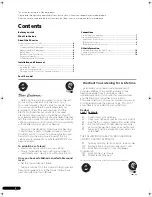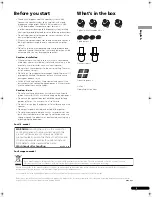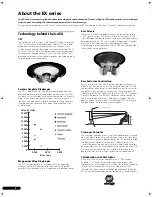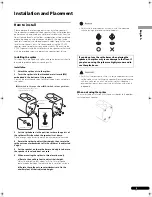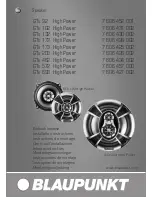
2
En
Thank you for buying this Pioneer product.
Please read through these operating instructions so you will know how to operate your model properly.
After you have finished reading the instructions, put them away in a safe place for future reference.
Contents
Before you start
What’s in the box
About the EX series
Technology behind the S-4EX
. . . . . . . . . . . . . . . . . . . . . . . . . . . . . 4
CST
. . . . . . . . . . . . . . . . . . . . . . . . . . . . . . . . . . . . . . . . . . . . . . . . 4
Ceramic Graphite Diaphragm
. . . . . . . . . . . . . . . . . . . . . . . . . . . . 4
Magnesium Alloy Diaphragm
. . . . . . . . . . . . . . . . . . . . . . . . . . . . 4
Bass Drivers
. . . . . . . . . . . . . . . . . . . . . . . . . . . . . . . . . . . . . . . . . 4
Bass Enclosure Construction
. . . . . . . . . . . . . . . . . . . . . . . . . . . . 4
Crossover Networks
. . . . . . . . . . . . . . . . . . . . . . . . . . . . . . . . . . . 4
Collaboration with Air Studios
. . . . . . . . . . . . . . . . . . . . . . . . . . . 4
Installation and Placement
How to install
. . . . . . . . . . . . . . . . . . . . . . . . . . . . . . . . . . . . . . . . . 5
Installing the spikes
. . . . . . . . . . . . . . . . . . . . . . . . . . . . . . . . . . . 5
When not using the spikes
. . . . . . . . . . . . . . . . . . . . . . . . . . . . . . 5
Choosing Where To Place The Speaker Systems
. . . . . . . . . . . . . 6
Connections
Connecting to an amplifier
. . . . . . . . . . . . . . . . . . . . . . . . . . . . . . . .7
Connecting the cables
. . . . . . . . . . . . . . . . . . . . . . . . . . . . . . . . . . .7
Single-Wire Connections
. . . . . . . . . . . . . . . . . . . . . . . . . . . . . . . .8
Bi-Wire Connections
. . . . . . . . . . . . . . . . . . . . . . . . . . . . . . . . . . .8
Bi-Amplification Connections
. . . . . . . . . . . . . . . . . . . . . . . . . . . .9
Other Information
Attaching/Removing the Grille Cover
. . . . . . . . . . . . . . . . . . . . . . .10
Cleaning the speaker cabinet
. . . . . . . . . . . . . . . . . . . . . . . . . . . . .10
Specifications
. . . . . . . . . . . . . . . . . . . . . . . . . . . . . . . . . . . . . . . .10
For U.S. model
S001_En
Selecting fine audio equipment such as the unit
you’ve just purchased is only the start of your
musical enjoyment. Now it’s time to consider how
you can maximize the fun and excitement your
equipment offers. This manufacturer and the
Electronic Industries Association’s Consumer
Electronics Group want you to get the most out of
your equipment by playing it at a safe level. One that
lets the sound come through loud and clear without
annoying blaring or distortion-and, most importantly,
without affecting your sensitive hearing.
Sound can be deceiving. Over time your hearing
“comfort level” adapts to higher volumes of sound.
So what sounds “normal” can actually be loud and
harmful to your hearing. Guard against this by
setting your equipment at a safe level BEFORE your
hearing adapts.
To establish a safe level:
• Start your volume control at a low setting.
• Slowly increase the sound until you can hear it
comfortably and clearly, and without distortion.
Once you have established a comfortable sound
level:
• Set the dial and leave it there.
Taking a minute to do this now will help to prevent
hearing damage or loss in the future. After all, we
want you listening for a lifetime.
We Want You Listening For A Lifetime
Used wisely, your new sound equipment will
provide a lifetime of fun and enjoyment. Since
hearing damage from loud noise is often
undetectable until it is too late, this manufacturer
and the Electronic Industries Association’s
Consumer Electronics Group recommend you avoid
prolonged exposure to excessive noise. This list of
sound levels is included for your protection.
Decibel
Level Example
30
Quiet library, soft whispers
40 Living room, refrigerator, bedroom away from traffic
50
Light traffic, normal conversation, quiet office
60
Air conditioner at 20 feet, sewing machine
70
Vacuum cleaner, hair dryer, noisy restaurant
80 Average city traffic, garbage disposals, alarm clock
at two feet.
THE FOLLOWING NOISES CAN BE DANGEROUS
UNDER CONSTANT EXPOSURE
90 Subway, motorcycle, truck traffic, lawn mower
100 Garbage truck, chain saw, pneumatic drill
120 Rock band concert in front of speakers,
thunderclap
140 Gunshot blast, jet plane
180 Rocket launching pad
Information courtesy of the Deafness Research Foundation.
S-4EX_EN.book 2 ページ 2008年7月16日 水曜日 午後2時2分


